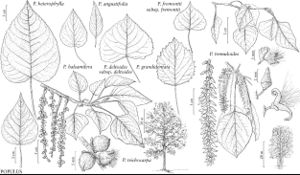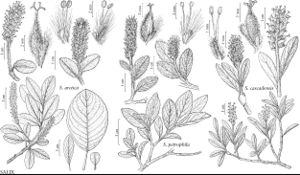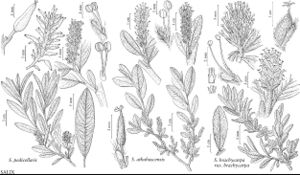Shrubs or trees, heterophyllous or not, sometimes clonal, forming clones by root shoots, rhizomes, layering, or stem fragmentation; glabrous or glabrescent to pubescent; branching monopodial or sympodial. Stems erect to pendent; branched. Leaves persistent, deciduous or marcescent, alternate (opposite or subopposite in Salix purpurea), spirally arranged, simple; stipules present or not; petiole present; blade margins toothed or entire, sometimes glandular. Peduncles present or absent. Inflorescences racemose or spicate, usually catkins, unbranched, sometimes fasciculate or racemelike cymes, flowering before or as leaves emerge or year-round; floral bract (1) subtending each flower, displaced onto pedicel or distinct, scalelike, apex entire, toothed, or laciniate; bract subtending pistillate flower deciduous or persistent. Pedicels present or absent. Flowers usually unisexual, sometimes bisexual, usually staminate and pistillate on different plants; sepals present or absent, or perianth modified into 1 or 2 nectaries, or a non-nectariferous disc; stamens 1–60(–70); filaments distinct or connate basally, slender; anthers longitudinally dehiscent; ovary 1, 2–7[–10]-carpellate, 1–7[–10]-locular; placentation usually parietal, sometimes axile on intruded, fused placentae; ovules 1–25 per ovary; style 1 per carpel, distinct or connate; stigmas 2–4, truncate, notched-capitate, or 2- or 3-lobed. Fruits capsular, baccate, or drupaceous. Seeds sometimes surrounded by arillate coma of relatively long, silky hairs; endosperm scant or absent.
Distribution
Nearly worldwide.
Discussion
Genera 50+, species ca. 1000 (4 genera, 123 species in the flora).
Taxonomic placement of the Salicaceae and the genera included in it have varied greatly. Some botanists (H. G. A. Engler and K. Prantl 1887–1915) treated it as a primitive member of the Dicotyledoneae and grouped it with other families having simple, apetalous, unisexual flowers arranged in catkins, the “Amentiferae.” At about the same time, others (C. E. Bessey 1915) took a different view, regarding the simple flowers as the result of reduction, and placed the taxa in Caryophyllales. As early as 1905, H. Hallier could see that there were similarities between Salicaceae and Flacourtiaceae; at the time, he was vigorously challenged by E. Gilg (1915). A. D. J. Meeuse (1975) summarized evidence for a close relationship between these families, including wood anatomy, phytochemistry, host-parasite relationships (including rust fungi), and morphology. He concluded that the Salicaceae could be combined with the Flacourtiaceae, “perhaps as a tribe.” A. Cronquist (1988) and R. F. Thorne (1992b) placed the Salicaceae, in a narrow sense, in Violales near Flacourtiaceae.
Molecular studies support a close relationship between Salicaceae and Flacourtiaceae in Malpighiales and show that Flacourtiaceae, in a broad sense, is paraphyletic. Based on a study of plastid rbcL DNA sequences, Salix and Populus were nested within a subset of 52 genera of Flacourtiaceae (M. W. Chase et al. 2002). Chase et al. proposed moving some genera from broadly circumscribed Flacourtiaceae to Salicaceae. Other studies, based on different gene sequences, came to the same conclusion (O. I. Nandi et al. 1998; V. Savolainen et al. 2000; K. W. Hilu et al. 2003; Angiosperm Phylogeny Group 2003). The discovery of the extinct fossil genus Pseudosalix (L. D. Boucher et al. 2003), from the Eocene Green River Formation of Utah, provided further support for placing some members of Flacourtiaceae in Salicaceae. The well-preserved Pseudosalix fossils, in which reproductive structures are directly associated with the leaves, occur intermixed with Populus fossils. The leaves are slender and have salicoid teeth, inflorescences are cymose, flowers are unisexual, pedicellate, tetrasepalous, and 3- or 4-carpellate, and seeds are comose, i.e., having characteristics intermediate between Salicaceae and Flacourtiaceae.
The presence, in both families, of salicoid teeth is often cited in support of their close relationship (W. S. Judd 1997b; O. Nandi et al. 1998; M. W. Chase et al. 2002; H. P. Wilkinson 2007). Salicoid teeth were first recognized and defined as having the tip of the medial vein (seta) of the tooth retained as a dark, but not opaque, non-deciduous spherical callosity fused to the tooth apex and were reported to occur in Salicaceae and Idesia of the Flacourtiaceae (L. J. Hickey and J. A. Wolfe 1975). Nandi et al. reported that a broad survey of angiosperm leaves showed that salicoid teeth occur outside of Flacourtiaceae and Salicaceae only in Tetracentraceae.
Isozyme and cytological evidence show that Populus and Salix are ancient polyploids (D. E. Soltis and P. S. Soltis 1990; Wang R. and Wang J. 1991). All Salix and Populus species contain salicin (R. T. Palo 1984).
The genera often included in Salicaceae, in the narrow sense, are Chosenia, Populus, Salix (A. K. Skvortsov 1999), and, sometimes, Toisusu. Molecular studies (E. Leskinen and C. Alström-Rapaport 1999; T. Azuma et al. 2000) show that Chosenia is nested within Salix. H. Ohashi (2001) treated Toisusu as Salix subg. Pleuradinea Kimura and Chosenia as Salix subg. Chosenia (Nakai) H. Ohashi.
Selected References
Lower Taxa
Illustrations
Key
| 1 | Flowers in catkins; sepals absent; fruits capsules | > 2 |
| 1 | Flowers not in catkins; sepals present; fruits drupes or berries | > 3 |
| 2 | Buds 3-10-scaled (usually resinous); leaf blades usually less than 2 times as long as wide, venation ± palmate (basal secondary veins strong, paired, except in Populus angustifolia); stipules caducous; catkins pendulous, sessile; floral bracts: apex deeply or shallowly cut, pistillate floral bracts deciduous after flowering; flowers without nectaries (with a non-glandular, cup- or saucer-like disc); stamens 6-60(-70); stigmas 2-4; capsules 2-4-valved, narrowly ovoid to spherical. | Populus |
| 2 | Buds 1-scaled (oily in Salix barrattiana); leaf blades often more than 2 times as long as wide, venation usually pinnate; stipules persistent or absent; catkins erect, spreading, or ± pendulous, sessile or terminating flowering branchlets; floral bracts: apex entire, erose, 2-fid, or irregularly toothed, pistillate floral bracts persistent or deciduous after flowering; flowers: perianth reduced to adaxial nectary (rarely also with abaxial nectary, then distinct or connate into shallow cup); stamens 1, 2, or 3-10; stigmas 2; capsules 2-valved, obclavate to ovoid or ellipsoid. | Salix |
| 3 | Flowers in racemelike cymes or solitary; fruits drupes, 18-25 mm | Flacourtia |
| 3 | Flowers in fascicles; fruits berries, 4-7 mm. | Xylosma |


